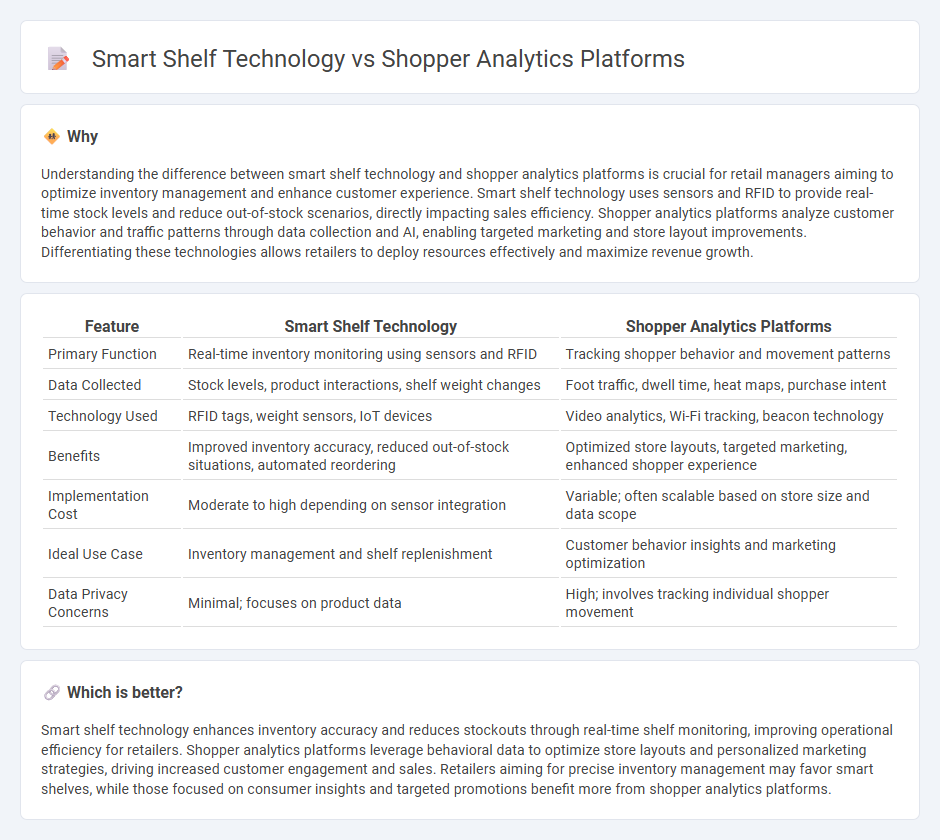
Smart shelf technology enhances inventory management by using sensors and RFID tags to provide real-time stock levels and product information, improving shopper experience and operational efficiency. Shopper analytics platforms collect data on customer behavior, such as foot traffic patterns, dwell time, and purchase history, enabling retailers to optimize store layout and personalized marketing strategies. Explore how integrating these innovative retail solutions can boost sales performance and customer satisfaction.
Why it is important
Understanding the difference between smart shelf technology and shopper analytics platforms is crucial for retail managers aiming to optimize inventory management and enhance customer experience. Smart shelf technology uses sensors and RFID to provide real-time stock levels and reduce out-of-stock scenarios, directly impacting sales efficiency. Shopper analytics platforms analyze customer behavior and traffic patterns through data collection and AI, enabling targeted marketing and store layout improvements. Differentiating these technologies allows retailers to deploy resources effectively and maximize revenue growth.
Comparison Table
| Feature | Smart Shelf Technology | Shopper Analytics Platforms |
|---|---|---|
| Primary Function | Real-time inventory monitoring using sensors and RFID | Tracking shopper behavior and movement patterns |
| Data Collected | Stock levels, product interactions, shelf weight changes | Foot traffic, dwell time, heat maps, purchase intent |
| Technology Used | RFID tags, weight sensors, IoT devices | Video analytics, Wi-Fi tracking, beacon technology |
| Benefits | Improved inventory accuracy, reduced out-of-stock situations, automated reordering | Optimized store layouts, targeted marketing, enhanced shopper experience |
| Implementation Cost | Moderate to high depending on sensor integration | Variable; often scalable based on store size and data scope |
| Ideal Use Case | Inventory management and shelf replenishment | Customer behavior insights and marketing optimization |
| Data Privacy Concerns | Minimal; focuses on product data | High; involves tracking individual shopper movement |
Which is better?
Smart shelf technology enhances inventory accuracy and reduces stockouts through real-time shelf monitoring, improving operational efficiency for retailers. Shopper analytics platforms leverage behavioral data to optimize store layouts and personalized marketing strategies, driving increased customer engagement and sales. Retailers aiming for precise inventory management may favor smart shelves, while those focused on consumer insights and targeted promotions benefit more from shopper analytics platforms.
Connection
Smart shelf technology and shopper analytics platforms are connected through real-time data collection that enhances inventory management and personalized marketing strategies. Smart shelves use sensors and RFID tags to monitor product levels and customer interactions, feeding data into shopper analytics platforms for actionable insights. These platforms analyze behavioral patterns and purchasing trends, enabling retailers to optimize shelf layouts and improve the shopping experience.
Key Terms
Shopper analytics platforms:
Shopper analytics platforms leverage data from in-store behaviors, purchase history, and demographic insights to optimize marketing strategies and enhance customer engagement. These platforms utilize AI and machine learning algorithms to analyze foot traffic patterns, product interactions, and conversion rates, providing retailers with actionable intelligence to boost sales and improve store layout. To discover how shopper analytics platforms can transform your retail strategy, explore in-depth solutions and case studies.
Customer Behavior Tracking
Shopper analytics platforms leverage AI-driven data aggregation from multiple touchpoints to provide comprehensive insights into customer behavior, purchase patterns, and foot traffic trends. Smart shelf technology uses embedded sensors and RFID tags for real-time inventory management and immediate tracking of shopper interactions at the product level. Discover how these technologies transform retail strategies by enhancing customer experience and operational efficiency.
Data Visualization Dashboards
Shopper analytics platforms offer comprehensive data visualization dashboards that aggregate customer behavior metrics, sales trends, and in-store interactions for actionable insights. Smart shelf technology enhances these dashboards by providing real-time inventory levels, product movement, and shelf engagement data through IoT sensors and AI. Explore how these integrated data visualization tools optimize retail operations and boost consumer experience.
Source and External Links
Customer Engagement Marketing with Shopper Analytics - Birdzi - Birdzi offers a comprehensive shopper analytics platform with real-time dashboards, campaign deep dives, and KIC(tm) scores to help retailers understand customer behavior, optimize marketing, and drive loyalty.
The 12 Top Retail Analytics Companies in 2024 - Woopra - Crisp provides advanced supply chain and inventory analytics, enabling retailers to optimize stock levels and improve efficiency based on real-time sales data and predictive insights.
Retail Analytics - ThoughtSpot - ThoughtSpot delivers AI-powered retail analytics that allow users to query live cloud data, uncover trends, and share interactive insights across teams for better decision-making.
 dowidth.com
dowidth.com